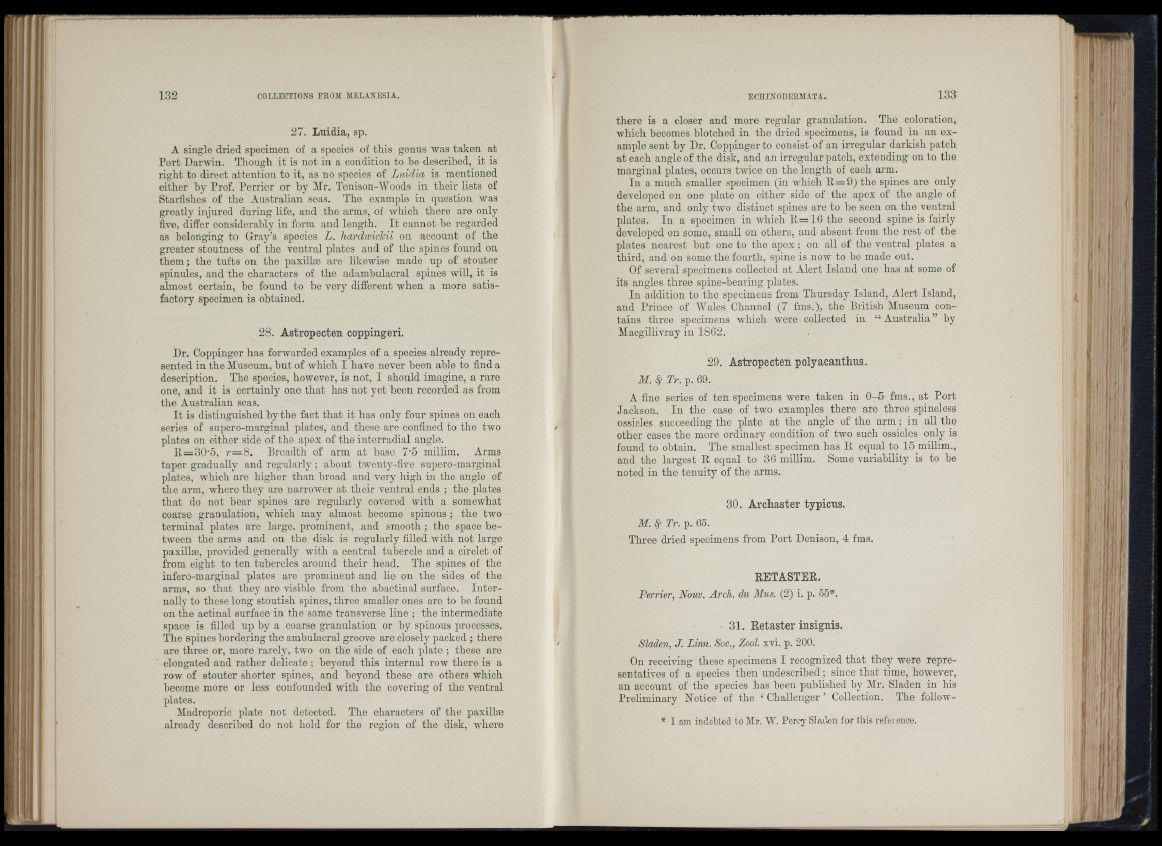
132
27. Luidia, sp.
A single dried specimen of a species of this genus was taken at
Port Darwin. Though it is not in a condition to be described, it is
right to direct attention to it, as no species of Luidia is mentioned
either by Prof. Perrier or by Mr. Tenison-Woods in their lists of
Starfishes of the Australian seas. The example in question was
greatly injured during life, and the arms, of which there are only
five, differ considerably in form and length. I t cannot be regarded
as belonging to Gray’s species A. liardwiclcii on account of the
greater stoutness of the ventral plates and of the spines found on
them; the tufts on the paxillae are likewise made up of stouter
spinules, and the characters of the adamhulacral spines wiU, it is
almost certain, be found to he very different when a more satisfactory
specimen is obtained.
28. Astropecten coppingeri.
Dr. Coppinger has forwarded examples of a species already represented
in the Museum, but of which I have never been able to find a
description. The species, however, is not, I should imagine, a rare
one, and it is certainly one that has not yet been recorded as from
the Australian seas.
I t is distinguished by the fact th at it has only four spines on each
series of supero-marginal plates, and these are confined to the two
plates on either side of the apex of the interradial angle.
E,=r30’5, r = 8 . Breadth of arm at base 7’5 millim. Arms
taper gradually aud regularly ; about twenty-fivo supero-marginal
plates, which are higher than broad and very high in the angle of
the arm, where they are narrower at their ventral ends ; the plates
th a t do not hear spines are regularly covered with a somewhat
coarse granulation, which may almost become spinous ; the two
terminal plates are large, prominent, and smooth ; the space between
the arms and on the disk is regularly filled with not large
paxillæ, provided generally with a central tubercle and a circlet of
from eight to ten tubercles around their head. The spines of the
infero-marginal plates are prominent and lie on the sides of the
arms, so th at they are visible from the abactinal surface. In te rnally
to these long stoutish spines, three smaller ones are to be found
on the actinal surface iu the same transverse line ; the intermediate
space is filled up by a coarse granulation or by spinous processes.
The spines bordering the amhulacral groove are closely packed ; there
are three or, more rarely, two on the side of each plate ; these are
elongated and rather delicate ; beyond this internal row there is a
row of stouter shorter spines, and beyond these are others which
become more or less confounded with the covering of the ventral
plates.
Madreporic plate not detected. The characters of the paxillæ
already described do not hold for the region of the disk, where
there is a closer and more regular granulation. The coloration,
which becomes blotched in the dried specimens, is found in an example
sent by Dr. Coppinger to consist of an irregular darkish patch
at each angle of the disk, and an irregular patch, extending on to the
marginal plates, occurs twice on the length of each arm.
In a much smaller specimen (in which B = 9 ) the spines are only
developed on one plate on either side of the apex of the angle of
the arm, and only two distinct spines are to he seen on the ventral
plates. In a specimen in which B = 1 6 the second spine is fairly
developed on some, small on others, and absent from the rest of the
plates nearest hut one to the apex ; on all of the ventral plates a
third, and on some the fourth, spine is now to be made out.
Of several specimens collected at Alert Island one has at some of
its angles three spine-hearing plates.
In addition to the specimens from Thursday Island, Alert Island,
and Prince of AVales Channel (7 fms.), the British Museum contains
three specimens which were collected in “ Australia ” by
Macgillivray in 1862.
! I
29. Astropecten polyacanthus.
M. 4- Tr. p. 69.
A fine series of ten specimens were taken in 0 -5 fms., at Port
Jackson. In the case of two examples there are three spineless
ossicles succeeding the jfiate at the angle of the a rm ; in all the
other cases the more ordinary condition of two such ossicles only is
found to obtain. The smallest specimen has B equal to 15 millim.,
and the largest B equal to 36 millim. Some variability is to be
noted in the tenuity of the arms.
\' I
30. Archaster typicns.
M. 4- Tr. p. 65.
Three dried specimens from Port Denison, 4 fms.
BETASTER.
Perrier, Nouv. Arch, du Mus. (2) i. p. 55*.
31. Retaster insignis.
Sladen, J. Linn. Soc., Zool. xvi. p. 200.
On receiving these specimens I recognized th at they were representatives
of a species then undescribed; since that time, however,
an account of the species has been published by Mr. Sladen in his
Preliminary Notice of the ‘ Challenger ’ Collection. The follow-
* I am indebted to Mr. W. Percy SJaden for this refei ence.